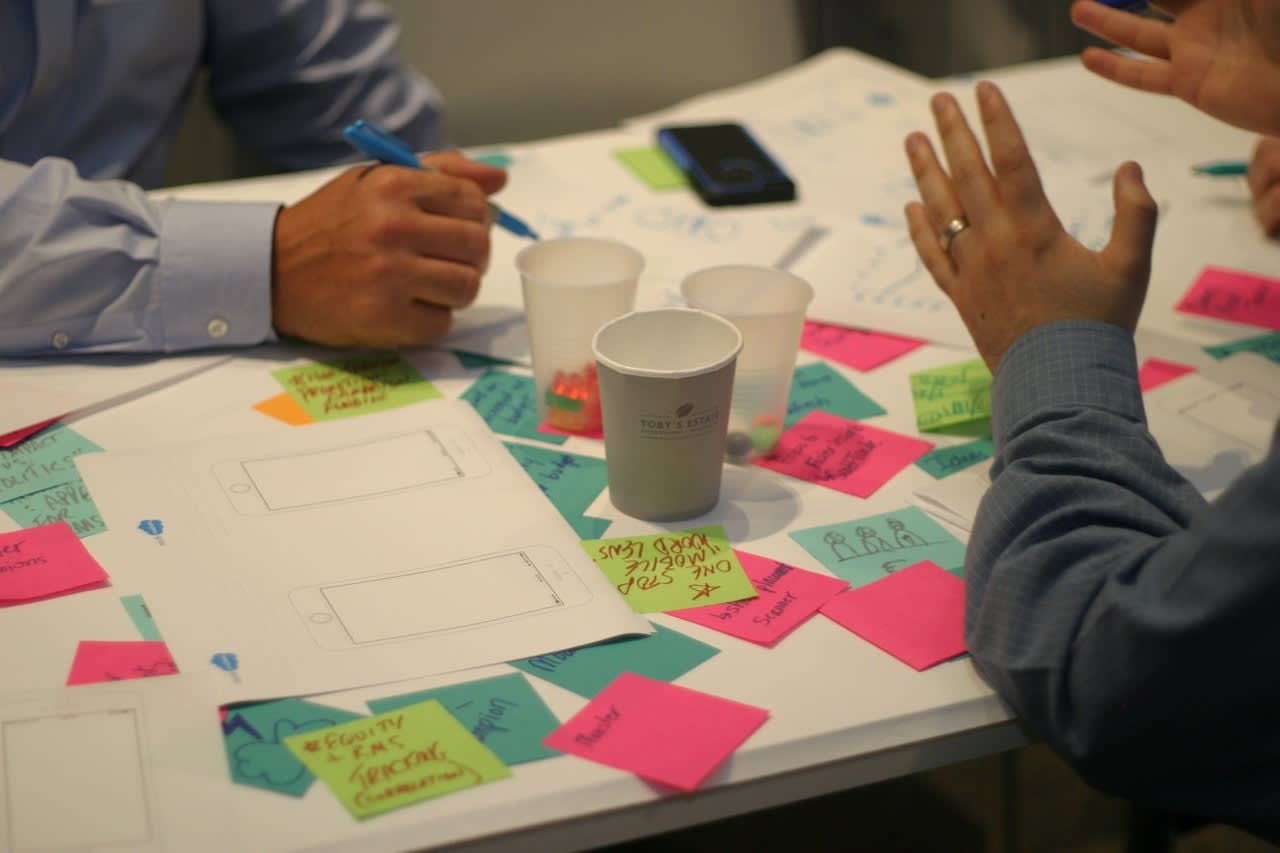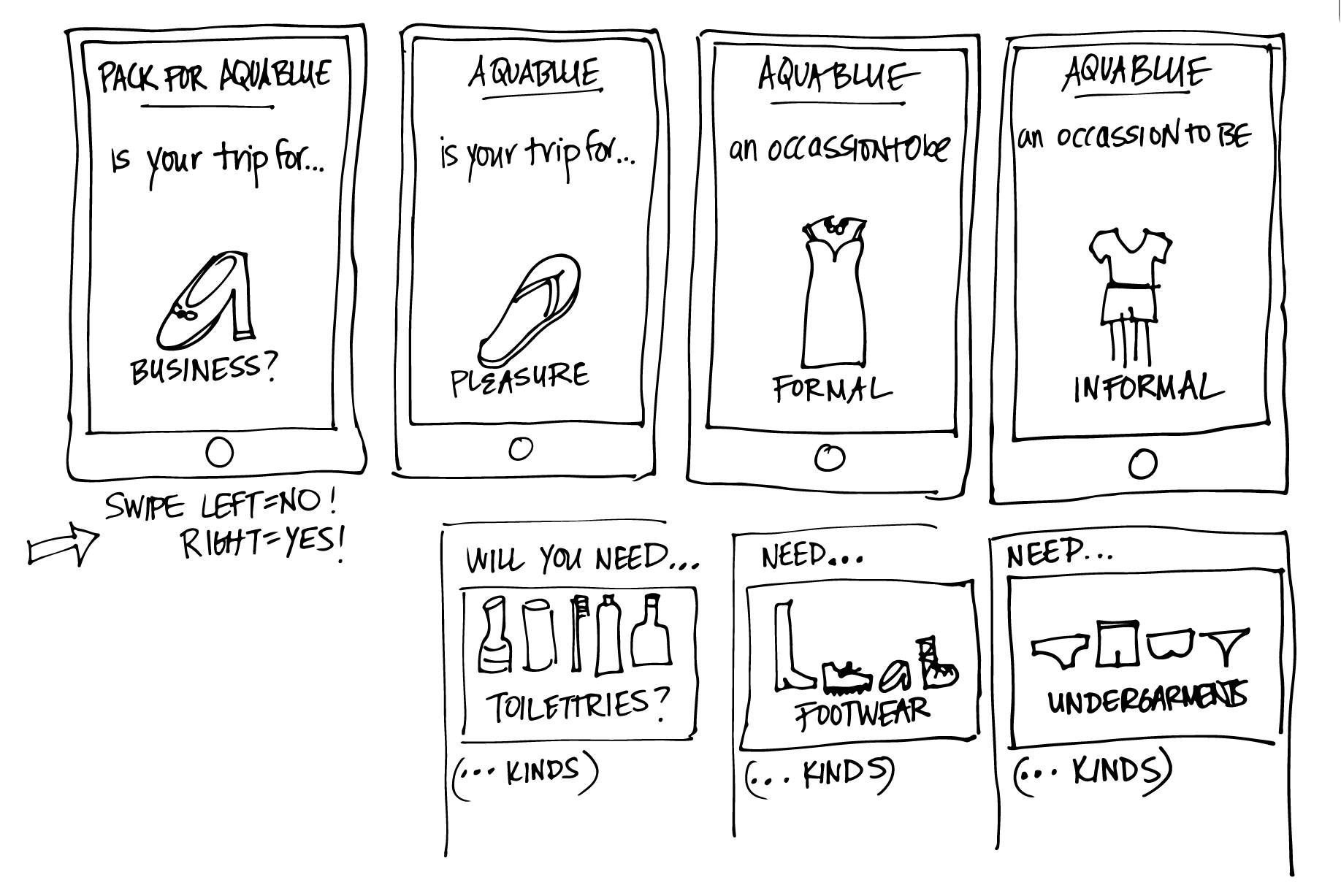Build Prototypes and Pitch Your Ideas
Learning Objectives
After completing this unit, you’ll be able to:
- Define what a prototype is.
- Describe the value of a minimal lovable product (MLP).
- Summarize how to prototype.
What Is Prototyping and Why Is It Important?
The link between big ideas and customer job stories is a product solution that delivers a transformational experience. To create this vision, you have to put pen to paper and prototype.
A prototype is a first pass, a simple sketch of an idea you want to implement. It doesn’t have to be pretty. It’s not completely thought out. It’s not final.
What distinguishes this Dare event from any other typical meeting is that you ask participants to “walk the talk” of innovation and sketch out solutions.
You might be concerned that the senior people in the room don’t have time to sketch. In our experience, teaching people of all backgrounds and levels how to make and create useful products is incredibly rewarding. Why?
- Prototypes make concrete the ideas that are in our heads. A prototype creates a physical manifestation of a dream that people can react to, build on, and improve.
- Prototypes are cheap and fast. Creating an app or a physical product can take months, if not years. Whereas creating a paper prototype, clickable wireframe, or 3D printed model can take minutes or hours for free or a fraction of the cost.
- Prototypes help creators take ownership of the solutions. With a diverse audience of people who have both technical and non-technical backgrounds, we recommend using paper prototypes to sketch your ideas.
So let’s get to it.

In Search of a Minimum Loveable Product
If you keep up with tech news and methods, you might be familiar with the concept of a minimum viable product (MVP). The term MVP was coined by SyncDev CEO Frank Robinson and popularized by Eric Ries, founder of the Lean Startup Movement. As Frank and his company have said, “An MVP is a mindset of the management and development teams. It says, think big for the long term but small for the short term. Think big enough that the first product is a sound launching pad for it and its next generation and the roadmap that follows, but not so small that you leave room for a competitor to get the jump on you.”

We, however, challenge you to pursue a minimum loveable product (MLP), as put forward by Laurence McCahill of Happy Startups. The difference between an MVP and an MLP is that with the MLP you focus on the minimum number of features needed to maximize love from a small population of core, ardent users.
If you design for your most loyal customers, you’re closer to ensuring immediate adoption. And we know that happy customers gladly take to social media and effectively become an extension of your marketing team.
How to Prototype
As you ask your participants to start prototyping, be prepared for resistance. People might start reaching for their phones, step backward, or even laugh. If they aren’t full-time product managers, designers, engineers, or closet entrepreneurs, their inclination might be to say, “I can’t do that.”
Your goal is to quickly show that they can! Often times, you find the real resistance is around insecurities about drawing. Eliminate that fear by taking 5 minutes to play Pictionary. Remind everyone that they don’t have to be Picasso to get their point across.
Next, walk through an example of how to prototype with an app they’re all familiar with, for example, a commonly used transportation app that we can’t mention by name. Ask people to shout out the main steps of the process.
- Sign up
- Load your credit card
- Find a car in your location
- Enter your destination
- Request your pickup
- Rate your driver
You’ll find that participants start to realize that they understand the phases. As they are shouting out the steps, use a big black marker on a whiteboard to draw the key visual icons associated with that phase: a gear symbol for sign-up, a dollar sign for payment options, a map pin icon for finding a destination, a text bar for entering a destination, a request button, and then finally a five-star rating. Doable, right?
Break your participants into groups and ensure that at least one member has a design, product, or development background to coach their peers.
How does this play out with our friends at Aqua Blue?
One team has amassed an entire wall of doodles, sketches, and stickies from the previous rounds of inspiration work. They were compelled by the archetype presentation and the distinction between Wistful Worriers and Dauntless Delegators. They also enjoyed learning about emerging startups that are delivering products to customers, literally in a box, for a subscription fee.
This team comes up with the idea for Aqua Box. It’s an initiative where guests don’t have to pack a bag for their travel. Instead, after booking a room, guests can choose from a menu of clothing, shoes, athletic apparel, evening wear, jewelry, and toiletries. When they arrive in their room, a box is waiting for them with all the items they need to use or wear for the trip. Guests can either keep what they like or send it all back after their stay.
You like, right?
They sketched out their experience like this.

Back to you and your team. This is the time to hand out prototyping templates, and work in small groups to take the best ideas and translate them into a multi-step experience. Have fun and turn up the music!
Pitch and Prioritize Your Ideas
After teams have had time to sketch, the energy level in the room is high. An effective way for groups to hear all concepts and select the best ideas is to hold a pitch contest. Like contestants on entrepreneurial-pitch reality TV shows, and startup founders in real life, each group has 1–2 minutes to present a compelling business value. The presentation speaks clearly to a customer need and is exciting, believable, and valuable.
Using an idea-pitching competitive approach requires organizing judges, often a panel of leaders and customers combined. Select the winners by applause or by giving each individual dot stickers to allocate to teams as they see fit. After all the pitches, individuals can silently vote for their favorites. The team with the highest count wins. Alright, you’ve now tackled the Dare phase.
Don’t forget to circle back with participants after this event or series of events with:
- A list of who participated (to remind everyone who is accountable)
- Summary of the process and topics covered
- Final ideas presented and top concept chosen
- Lots of pictures and video to show how fun and interactive the process was